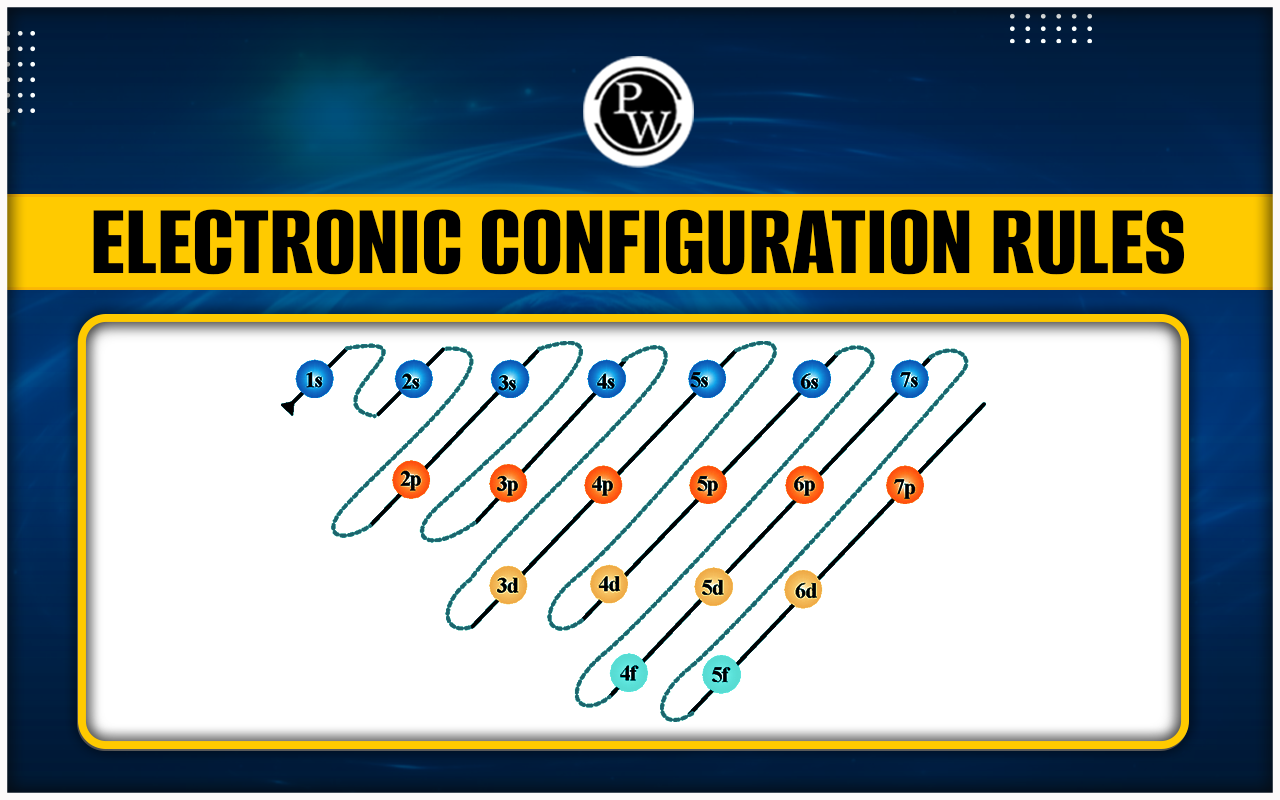

Electronic Configuration Rules : Welcome, budding scientists, to the fascinating realm of electronic configurations! In the microscopic world of atoms, electrons play a crucial role in determining an element's properties. Understanding how electrons are arranged within atoms is essential for comprehending chemical bonding, reactivity, and the behaviour of matter. In this article, we'll explore three fundamental rules that govern electronic configurations: the Aufbau Principle, (n + l) Rule By the end of our journey, you'll have a clear understanding of these rules and their significance in chemistry.
Before we dive into the specifics of each rule, let's first grasp the concept of electronic configurations. Electronic configuration refers to the arrangement of electrons within an atom's electron shells and subshells. These configurations are based on a set of rules that dictate how electrons fill various orbitals around the nucleus.
Rules of Electrons
The distribution of electrons in various shells, subshells and orbitals, in an atom of an element, is called its electronic configuration.
Representation : nl x
Where,
n → Shell number
l → Represents subshell
x → Number of electrons in subshell
For example: -
Electronic Configuration Rules : Aufbau Principle
The Aufbau Principle, also known as the building-up principle, states that electrons fill atomic orbitals in order of increasing energy. This means that electrons occupy the lowest energy orbitals first before moving to higher energy orbitals. The order of filling orbitals is determined by the increasing order of principal quantum numbers (n) and azimuthal quantum numbers.
-
Aufbau principle gives a sequence in which various subshell are filled up depending on the relative order of the energies of various subshell.
-
Principle: The subshell with minimum energy is filled up first when this subshell obtained maximum quota of electrons then the next subshell of higher energy starts filling.
-
The sequence in which various subshell are filled are as follows.
1s 2 , 2s 2 , 2p 6 , 3s 2 , 3p 6 , 4s 2 , 3d 10 , 4p 6 , 5s 2 , 4d 10 , 5p 6 , 6s 2 , 4f 14 , 5d 10 , 6p 6 , 7s 2 , 5f 14 , 6d 10 , …
Example Of Electronic Configuration Rules
1 H → 1s 1
2 He → 1s 2
3 Li → 1s 2 , 2s 1
4 Be → 1s 2 , 2s 2
5 B → 1s 2 , 2s 2 , 2p 1
6 C → 1s 2 , 2s 2 , 2p 2
7 N → 1s 2 , 2s 2 , 2p 3
8 O → 1s 2 , 2s 2 , 2p 4
9 F → 1s 2 , 2s 2 , 2p 5
10 Ne → 1s 2 , 2s 2 , 2p 6
11 Na → 1s 2 , 2s 2 , 2p 6 , 3s 1
12 Mg → 1s 2 , 2s 2 , 2p 6 , 3s 2
13 Al → 1s 2 , 2s 2 , 2p 6 , 3s 2 , 3p 1
14 Si → 1s 2 , 2s 2 , 2p 6 , 3s 2 , 3p 2
15 P → 1s 2 , 2s 2 , 2p 6 , 3s 2 , 3p 3
16 S → 1s 2 , 2s 2 , 2p 6 , 3s 2 , 3p 4
17 Cl → 1s 2 , 2s 2 , 2p 6 , 3s 2 , 3p 5
18 Ar → 1s 2 , 2s 2 , 2p 6 , 3s 2 , 3p 6
19 K → 1s 2 , 2s 2 , 2p 6 , 3s 2 , 3p 6 , 4s 2
20 Ca → 1s 2 , 2s 2 , 2p 6 , 3s 2 , 3p 6 , 4s 2
21 Sc → 1s 2 , 2s 2 , 2p 6 , 3s 2 , 3p 6 , 4s 2 , 3d 1
22 Ti → 1s 2 , 2s 2 , 2p 6 , 3s 2 , 3p 6 , 4s 2 , 3d 2
23 V → 1s 2 , 2s 2 , 2p 6 , 3s 2 , 3p 6 , 4s 2 , 3d 3
24 Cr → 1s 2 , 2s 2 , 2p 6 , 3s 2 , 3p 6 , 4s 1 , 3d 5 [Exception]
25 Mn → 1s 2 , 2s 2 , 2p 6 , 3s 2 , 3p 6 , 4s 2 , 3d 5
26 Fe → 1s 2 , 2s 2 , 2p 6 ,3s 2 , 3p 6 , 4s 2 , 3d 6
27 Co → 1s 2 , 2s 2 , 2p 6 , 3s 2 , 3p 6 , 4s 2 , 3d 7
28 Ni → 1s 2 , 2s 2 , 2p 6 , 3s 2 ,3p 6 , 4s 2 , 3d 8
29 Cu → 1s 2 , 2s 2 , 2p 6 , 3s 2 , 3p 6 , 4s 1 , 3d 10 [Exception]
30 Zn → 1s 2 , 2s 2 , 2p 6 , 3s 2 , 3p 6 , 4s 2 , 3d 10
Methods Of Electronic Configuration
Methods Of Electronic Configuration : Electronic configuration can be written by following different methods :
2Fe → (1) 1s 2 , 2s 2 , 2p 6 , 3s 2 , 3p 6 , 4s 2 , 3d 6
(2) 1s 2 , 2s 2 , 2p 6 , 3s 2 , 3p 6 , 3d 6 , 4s 2
(3) 1s 2 , 2s 2 p 6 , 3s 2 p 6 d 6 , 4s 2
2 8 14 2
(4) [Ar] 4s 2 3d 6
n → Outer most Shell or Ultimate Shell or Valence Shell
In this Shell electrons are called as Valence electrons or this is called core charge.
(n – 1) → Penultimate Shell or core or pre-valence Shell
(n –2) → Pre-penultimate Shell
If we remove the last ‘n’ Shell (ultimate Shell) then the remaining shells are collectively called as kernel.
Ex.
Exception of Aufbau principle
In some cases, it is seen that the electronic configuration is slightly different from the arrangement given by Aufbau principle. A simple reason behind this is that half filled & full filled subshell have got extra stability.
(n + l) Rule (For multi-electron species):
According to it the sequence in which various subshells are filled up can also be determined with the help of (n +l) value for a given subshell.
Principle of (n + l) rule
Principle of (n + l) rule : The subshell with lowest (n + l ) value is filled up first. When two or more subshell have same (n + l ) value then the subshell with lowest value of n is filled up first.
In case of H-atom: Energy only depends on principal quantum number
1s < 2s = 2p < 3s = 3p = 3d < 4s = 4p = 4d = 4f < ………….
Sub Shell n l n + l
1s 1 0 1
2s 2 0 2
2p 2 1 3 (1)
3s 3 0 3 (2)
3p 3 1 4 (1)
4s 4 0 4 (2)
3d 3 2 5 (1)
4p 4 1 5 (2)
5s 5 0 5 (3)
4d 4 2 6 (1)
5p 5 1 6 (2)
6s 6 0 6 (3)
Order: 1s 2 , 2s 2 , 2p 6 , 3s 2 , 3p 6 , 4s 2 , 3d 10 , 4p 6 , 5s 2 , 4d 10 , 5p 6 , 6s 2 , 4f 14 , 5d 10 , 6p 6 , 7s 2 , 5f 14 , 6d 10 , ….
Important Point To Remember
1.
Total spin
× no. of unpaired e
–
.
2.
Magnetic moment (μ) =
Where ‘n’ is no. of unpaired electron.
3. Paramagnetic: Those species which contain one or more than one unpaired electron.
4. Diamagnetic: Those species which do not contain any unpaired electron.
Solved Examples Of Electronic Configuration Rules
Q1. Calculate the number of unpaired electrons in Cr +3 .
Sol. Cr 3+ → 1s 2 2s 2 2p 6 3s 2 3p 6 4s 0 3d 3
In Cr +3 , 3 electrons are unpaired.
Electronic Configuration Rules FAQs
Q.1 : What is the Aufbau Principle, and how does it determine the electronic configuration of atoms?
Q.2 : How does the Aufbau Principle relate to the (n + l) Rule in determining the order of filling orbitals?
Q.3 : What is the significance of the (n + l) Rule in electronic configuration?
Q.4 : How does the (n + l) Rule help predict the electronic configurations of atoms?
Q.5 : Is the (n + l) Rule always followed in electronic configuration, or are there exceptions?
Q.6 : How do the Aufbau Principle and the (n + l) Rule contribute to our understanding of atomic structure and chemical behaviour?












